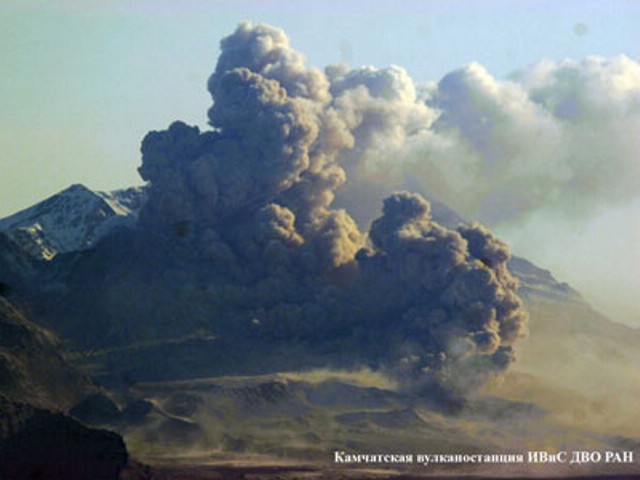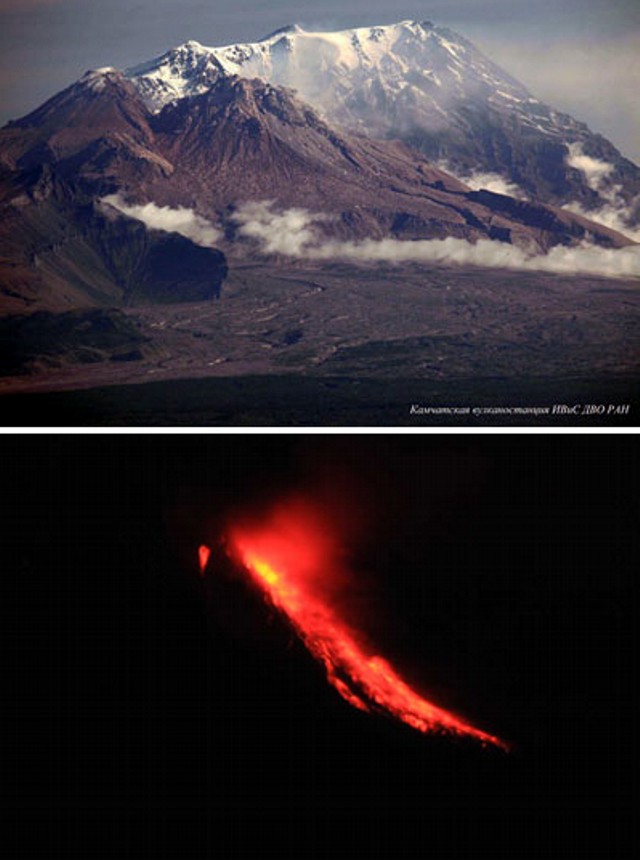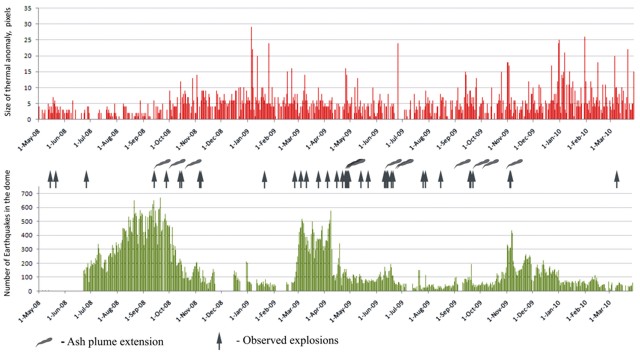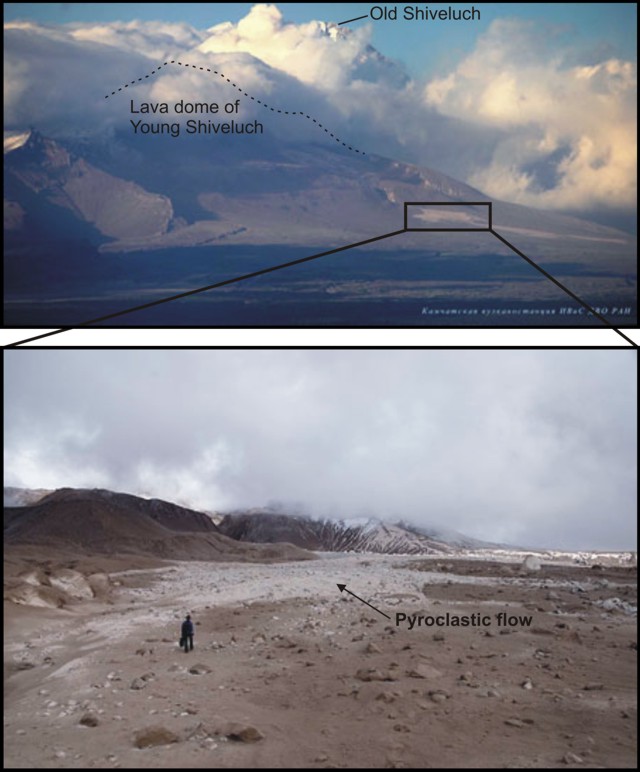Report on Sheveluch (Russia) — March 2010
Bulletin of the Global Volcanism Network, vol. 35, no. 3 (March 2010)
Managing Editor: Richard Wunderman.
Sheveluch (Russia) Near-constant dome growth during May 2008 through March 2010
Please cite this report as:
Global Volcanism Program, 2010. Report on Sheveluch (Russia) (Wunderman, R., ed.). Bulletin of the Global Volcanism Network, 35:3. Smithsonian Institution. https://doi.org/10.5479/si.GVP.BGVN201003-300270
Sheveluch
Russia
56.653°N, 161.36°E; summit elev. 3283 m
All times are local (unless otherwise noted)
Volcanism at Shiveluch that has been almost continuous since 1980 remained so from May 2008 through March 2010. During that time the lava dome was active and frequently growing, and produced moderate and weak explosions (figure 18). The most active phases took place during July-October 2008, March-April 2009, and November-December 2009 (figure 19).
During the two years discussed, there were many short-lived ash plumes (1-3 km above the dome), ash clouds produced by rockfalls and avalanches, and strong explosions that generated long-distance plumes (those with 'ash cloud' symbols above the arrows, figure 19). The large explosive eruptions of 26 April and 23 June 2009 sent respective ash plumes to 510 km and 754 km distances (table 8). The day after the earlier event, there was clear visibility on 27 April (figure 20).
Table 8. Significant explosions and ash plumes recorded at Shiveluch from May 2008 to March 2010. Plumes lower than ~1.2 km above the dome and seen for less than 10 km from the vent were omitted. Data courtesy of KVERT.
| Date | Plume altitude (m) | Plume extension (km) |
| 14 May 2008 | 5800 | -- |
| 20 May 2008 | 5500 | -- |
| 27 May 2008 | 3600 | -- |
| 25 Jun 2008 | 4200 | -- |
| 13 Sep 2008 | 6500 | 100 km NE |
| 28 Sep 2008 | 5000 | -- |
| 01 Oct 2008 | -- | 70 km S, W |
| 14 Oct 2008 | 6000 | -- |
| 16 Oct 2008 | 4500 | -- |
| 19 Oct 2008 | -- | 30 km E |
| 20 Oct 2008 | -- | 62 km E |
| 05-06 Nov 2008 | 4000 | -- |
| 04 Dec 2008 | -- | 25 km NE |
| 17 Jan 2009 | -- | 10 km E |
| 20 Jan 2009 | 4500 | -- |
| 25 Feb 2009 | 5500 | -- |
| 04 Mar 2009 | 4700 | -- |
| 10 Mar 2009 | 6000 | -- |
| 24 Mar 2009 | 7500 | -- |
| 27-29 Mar 2009 | -- | 10 km SE |
| 04 Apr 2009 | 4500 | -- |
| 05 Apr 2009 | -- | 10 km E |
| 15, 22 Apr 2009 | 4000 | -- |
| 25 Apr 2009 | 6700 | 50 km SE |
| 26 Apr 2009 | 5000 | 510 km SE |
| 27-29 Apr 2009 | 5000 | 107-120 km NE |
| 13 May 2009 | 5000 | -- |
| 22 May 2009 | 4000 | -- |
| 10 Jun 2009 | 7700 | -- |
| 11 Jun 2009 | 4500 | 140 km SW |
| 13-14 Jun 2009 | 5500-6100 | -- |
| 18 Jun 2009 | 5700 | -- |
| 20 Jun 2009 | 5000 | -- |
| 23 Jun 2009 | -- | 754 km S |
| 24 Jun 2009 | -- | 28 km NW |
| 25 Jun 2009 | -- | 95 km |
| 03 Jul 2009 | -- | 20 km SE |
| 18 Jul 2009 | -- | 34 km E |
| 24 Jul 2009 | 5000 | -- |
| 27 Jul 2009 | 5000 | 10 km E |
| 02 Aug 2009 | -- | 23 km E |
| 15 Aug 2009 | 4500 | -- |
| 31 Aug 2009 | -- | 107 km E |
| 02 Sep 2009 | -- | 20 km S |
| 11 Sep 2009 | 15000 | -- |
| 18-19 Sep 2009 | 5000-5500 | -- |
| 20 Sep 2009 | -- | 30 km NW |
| 22 Sep 2009 | 4500 | 70 km SW |
| 29 Sep 2009 | -- | 45 km E |
| 02-03 Oct 2009 | -- | 30-60 km SE |
| 30 Oct 2009 | -- | 255 km E |
| 04-05 Nov 2009 | 4200-4500 | -- |
| 10 Mar 2010 | 5500 | -- |
| 11 Mar 2010 | -- | 10 km E |
 |
Figure 20. Strong explosion on 26 April 2009 at Shiveluch produced a pyroclastic flow on the S slope and a resulting ash plume that extended 120 km to the NE. Photo by Yuri Demyanchuk, IVS RAS. |
KVERT noted that on 11 September 2009 there were strong explosions. Based on interpretations of seismic data, the inferred ash plumes that day rose to an altitude greater than 15 km above sea level. The seismic network then detected 8 minutes of signals interpreted as pyroclastic flows from the lava dome; resulting plumes rose to an altitude of ~ 15 km. Cloud cover prevented visual observations. Ten more events characterized as ash explosions and either pyroclastic flows or avalanches were detected. Seismicity then decreased during 11-12 September. A visit during clear visibility on 13 September revealed fresh pyroclastic-flow deposits (figure 21).
Seismicity. Extended intervals of low-level seismicity were detected at the dome in May and June 2008, during May to October 2009, and to some extent from January through March 2010 (figure 19, bottom). A plot of regional seismicity during December 2009-5 April 2010 in a 70-km-diameter circle around Shiveluch (figure 22) indicates SW-dipping epicenters that rise to shallow depths under Shiveluch (and similarly for other volcanoes in the Kliuchevskoi group).
Geological Summary. The high, isolated massif of Sheveluch volcano (also spelled Shiveluch) rises above the lowlands NNE of the Kliuchevskaya volcano group. The 1,300 km3 andesitic volcano is one of Kamchatka's largest and most active volcanic structures, with at least 60 large eruptions during the Holocene. The summit of roughly 65,000-year-old Stary Shiveluch is truncated by a broad 9-km-wide late-Pleistocene caldera breached to the south. Many lava domes occur on its outer flanks. The Molodoy Shiveluch lava dome complex was constructed during the Holocene within the large open caldera; Holocene lava dome extrusion also took place on the flanks of Stary Shiveluch. Widespread tephra layers from these eruptions have provided valuable time markers for dating volcanic events in Kamchatka. Frequent collapses of dome complexes, most recently in 1964, have produced debris avalanches whose deposits cover much of the floor of the breached caldera.
Information Contacts: Kamchatka Volcanic Eruptions Response Team (KVERT), Institute of Volcanology and Seismology (IV&S) Far East Division, Russian Academy of Sciences (FED RAS), Kamchatka Branch of the Geophysical Service of the Russian Academy of Sciences (KB GS RAS), Piip Ave. 9, Petropavlovsk-Kamchatsky, 683006, Russia (URL: http://www.kscnet.ru/ivs, http://www.emsd.ru/~ssl/monitoring/main.htm); Yuri Demyanchuk, IV&S FED RAS; Alaska Volcano Observatory (AVO), a cooperative program of the U.S. Geological Survey, 4200 University Drive, Anchorage, AK 99508-4667, USA (URL: http://www.avo.alaska.edu/), the Geophysical Institute, University of Alaska, PO Box 757320, Fairbanks, AK 99775-7320, USA, and the Alaska Division of Geological and Geophysical Surveys, 794 University Ave., Suite 200, Fairbanks, AK 99709, USA.





